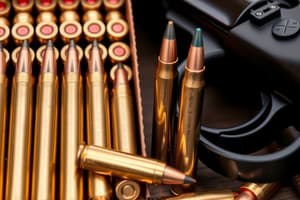Podcast
Questions and Answers
What is the purpose of adopting a proper shooting stance?
What is the purpose of adopting a proper shooting stance?
- To improve the accuracy of long-range shots
- To reduce the need for firearm maintenance
- To engage in conversation with targets
- To provide stability and enable proper movement (correct)
In the offensive ready stance, where should the weapon-side leg be positioned relative to the support-side foot?
In the offensive ready stance, where should the weapon-side leg be positioned relative to the support-side foot?
- Behind the support-side foot
- Aligned with the toe and heel (correct)
- To the side of the support-side foot
- In front of the support-side foot
What is a key aspect of the kneeling stance?
What is a key aspect of the kneeling stance?
- Pointing the muzzle of the firearm downrange (correct)
- Remaining fully upright with no knee contact
- Keeping both feet planted with toes pointing outwards
- Keeping the firearm at eye level above the head
When is the compressed ready position most appropriate to use?
When is the compressed ready position most appropriate to use?
What should the primary arm do when assuming the compressed ready position?
What should the primary arm do when assuming the compressed ready position?
Which of the following is NOT a step in assuming the offensive ready stance?
Which of the following is NOT a step in assuming the offensive ready stance?
Which defect involves a tearing away of a layer of the case wall, potentially weakening it?
Which defect involves a tearing away of a layer of the case wall, potentially weakening it?
What type of defect is characterized by a dimple or depression in the case?
What type of defect is characterized by a dimple or depression in the case?
Which of the following is NOT listed as an abnormality when inspecting ammunition?
Which of the following is NOT listed as an abnormality when inspecting ammunition?
To ensure safe handling of ammunition, it's essential to do what with the primer?
To ensure safe handling of ammunition, it's essential to do what with the primer?
What can be a consequence of using reloaded ammunition for duty purposes?
What can be a consequence of using reloaded ammunition for duty purposes?
Which of the following is a recommended practice when inspecting ammunition?
Which of the following is a recommended practice when inspecting ammunition?
What type of degradation involves the layering of the case with foreign materials?
What type of degradation involves the layering of the case with foreign materials?
What is a significant risk of failing to properly maintain ammunition?
What is a significant risk of failing to properly maintain ammunition?
Which action should be avoided to ensure the safety of ammunition during handling?
Which action should be avoided to ensure the safety of ammunition during handling?
What is the primary reason for washing your hands before handling ammunition?
What is the primary reason for washing your hands before handling ammunition?
What is the focus of Unit 3 in the Criminal Justice training?
What is the focus of Unit 3 in the Criminal Justice training?
Why is it important to know the nomenclature of semiautomatic pistols?
Why is it important to know the nomenclature of semiautomatic pistols?
What common elements do all firearms share?
What common elements do all firearms share?
Which type of pistol is most commonly carried by criminal justice officers according to this training?
Which type of pistol is most commonly carried by criminal justice officers according to this training?
What should a trainee ensure regarding the specific semiautomatic pistol they use?
What should a trainee ensure regarding the specific semiautomatic pistol they use?
What is the goal of the lesson on semiautomatic pistols?
What is the goal of the lesson on semiautomatic pistols?
What might differ between semiautomatic pistols based on the manufacturer?
What might differ between semiautomatic pistols based on the manufacturer?
What should trainees refer to for identifying the parts of a semiautomatic pistol?
What should trainees refer to for identifying the parts of a semiautomatic pistol?
What is critical for safe firearms operation on the range and in the field?
What is critical for safe firearms operation on the range and in the field?
What is the function of the magazine release in a semiautomatic pistol?
What is the function of the magazine release in a semiautomatic pistol?
Which component of a semiautomatic pistol is responsible for striking the primer?
Which component of a semiautomatic pistol is responsible for striking the primer?
What part of the grip is specifically designed for the fingers of the shooting hand to rest?
What part of the grip is specifically designed for the fingers of the shooting hand to rest?
What is the purpose of the slide stop lever?
What is the purpose of the slide stop lever?
What is the role of the accessory rail on a semiautomatic pistol?
What is the role of the accessory rail on a semiautomatic pistol?
Which component safely de-cocks the pistol by releasing spring tension?
Which component safely de-cocks the pistol by releasing spring tension?
Where is the front sight located on a semiautomatic pistol?
Where is the front sight located on a semiautomatic pistol?
What purpose does the trigger guard serve in a semiautomatic pistol?
What purpose does the trigger guard serve in a semiautomatic pistol?
How does the frame/receiver contribute to a semiautomatic pistol's function?
How does the frame/receiver contribute to a semiautomatic pistol's function?
What should be ensured when reassembling the magazine?
What should be ensured when reassembling the magazine?
What is one cause of malfunction in a semiautomatic pistol?
What is one cause of malfunction in a semiautomatic pistol?
What is the first step in Phase I clearance to address a malfunction?
What is the first step in Phase I clearance to address a malfunction?
What should be done if Phase I clearance does not resolve the malfunction?
What should be done if Phase I clearance does not resolve the malfunction?
What phrase can help remember the steps in Phase I clearance?
What phrase can help remember the steps in Phase I clearance?
Which malfunction requires a certified armorer for repair?
Which malfunction requires a certified armorer for repair?
During which situation should you clear a malfunction while moving to cover?
During which situation should you clear a malfunction while moving to cover?
What should you do after tapping the magazine during Phase I clearance?
What should you do after tapping the magazine during Phase I clearance?
What malfunction can Phase I clearance NOT address?
What malfunction can Phase I clearance NOT address?
What action should be taken if the firearm is dirty and malfunctions occur?
What action should be taken if the firearm is dirty and malfunctions occur?
What is NOT a step included in Phase I clearance?
What is NOT a step included in Phase I clearance?
Study Notes
Ammunition Defects
- Scrape: An indentation in the casing wall caused by scratching or tearing.
- Dent: A dimple or depression in the casing.
- Corrosion: Oxidation or foreign materials like molds, fungi, or oil on the casing.
- Puncture: An opening in the casing body.
Ammunition Inspection
- Inspect ammunition before loading for defects.
- Check for scrapes, dents, corrosion, and punctures on the casing and rim.
- Ensure the projectile is firmly seated in the casing by feeling both ends.
- Verify the primer is properly seated and flush with the rim.
Ammunition Maintenance
- Use ammunition from reputable manufacturers only.
- Do not alter the original design of ammunition.
- Do not use reloads for duty ammunition.
- Do not drop or throw ammunition.
- Do not place ammunition in the radio holder of your patrol vehicle.
- Avoid using solvents and lubricants when handling ammunition.
- Wash hands before handling ammunition.
Semiautomatic Pistol Parts
- Accessory rail: Attaches lighting and sighting devices.
- Backstrap: The portion of the grip placed in the palm of the shooting hand.
- De-cocker: Safely de-cocks the pistol without allowing the hammer or striker to reach the round.
- Frame/receiver: Holds the internal parts and slide assembly.
- Front sight: Used for alignment for accurate shooting.
- Front strap: Portion of the grip that allows the fingers to rest.
- Hammer: Strikes the primer or firing pin to ignite the propellant.
- Magazine release: Releases the magazine from the frame.
- Muzzle/barrel: Provides a path for the bullet.
- Rear sight: Used for alignment for accurate shooting.
- Slide: Houses the firing pin, barrel, recoil spring, sights, and extractor.
- Slide lock/takedown lever: Allows for quick field stripping.
- Slide stop lever: Locks the slide in the open position.
- Trigger: Activates the pistol's operation.
- Trigger guard: Protects the trigger.
Semiautomatic Pistol Malfunctions
- Failure to feed: The round does not feed properly into the chamber.
- Failure to fire: The round does not ignite.
- Stovepipe: The empty casing jams between the slide and barrel.
- Failure to extract: The empty casing does not eject properly.
Semiautomatic Pistol Malfunction Clearance Methods
- Phase I Clearance: Used to fix failure to feed, failure to fire, stovepipe, and failure to extract malfunctions.
- Phase II Clearance: Used if Phase I does not resolve the malfunction.
Semiautomatic Pistol Stances
- Offensive ready stance: The same as the fighting stance used in Criminal Justice Defensive Tactics.
- Kneeling stance: Used when kneeling.
Semiautomatic Pistol Positions
- Compressed ready position: Used for covering a subject or moving through tight spaces.
Studying That Suits You
Use AI to generate personalized quizzes and flashcards to suit your learning preferences.
Related Documents
Description
This quiz covers the essential aspects of ammunition inspection and maintenance. You will learn to identify defects such as scrapes, dents, and corrosion, and the best practices for handling and maintaining ammunition. Ensure your knowledge is up to date for safe and effective usage.



